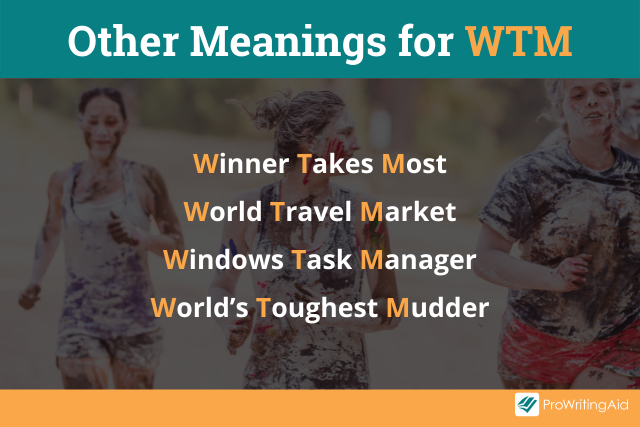Understanding WTM on Instagram: A Comprehensive Guide
Introduction
In the ever-evolving landscape of social media, acronyms and slang terms frequently emerge, creating a unique language that can often confuse users. One such acronym that has gained popularity, particularly on platforms like Instagram, is “WTM.” This article aims to provide an in-depth understanding of what WTM means, its various interpretations, and its significance in online communication. By the end, readers will have a comprehensive grasp of WTM and how to use it effectively in their interactions.
What Does WTM Mean?
WTM primarily stands for “What’s the move?” This phrase is commonly used to inquire about someone’s plans or intentions, especially in a social context. It serves as a casual invitation to engage in activities or events. However, WTM can also have other meanings, depending on the context in which it is used. These include:
- What’s the Matter?: Used to express concern or inquire about someone’s well-being.
- Whatever That Means: A phrase used to express confusion or skepticism about a statement.
Understanding the context in which WTM is used is crucial for effective communication on platforms like Instagram.
The Evolution of WTM on Social Media
As social media platforms have grown, so has the language used within them. WTM has evolved from a casual phrase among friends to a widely recognized acronym across various demographics. Initially popular among younger users, it has transcended age barriers and is now commonly used in diverse online communities.
Origin and Popularity
The rise of WTM can be attributed to the increasing reliance on abbreviations and shorthand in digital communication. With the fast-paced nature of social media, users often seek to convey messages quickly and efficiently. WTM fits this need perfectly, allowing users to ask about plans or express concern without lengthy explanations.
Contextual Usage of WTM
To fully understand WTM, it’s essential to explore its contextual usage. Here are some common scenarios in which WTM might be used:
1. Social Invitations
In social contexts, WTM is often used to ask about plans for the day or evening. For example:
- Example: “Hey, WTM tonight?”
This question invites the recipient to share their plans, making it a great way to coordinate social activities.
2. Expressing Concern
When used as “What’s the matter?”, WTM can indicate that someone is worried about a friend’s well-being. For instance:
- Example: “You seem upset, WTM?”
This usage shows empathy and invites the friend to share their feelings.
3. Indicating Confusion
In discussions where clarity is needed, WTM can be employed to express confusion. For example:
- Example: “He said he would come, but now he’s not. WTM?”
Here, the speaker is seeking clarification about the situation.
The Significance of WTM in Online Communication
The significance of WTM extends beyond its literal meaning. It reflects the dynamic nature of online communication and the need for brevity in a fast-paced digital world. By using acronyms like WTM, users can engage in conversations that are both efficient and expressive.
Enhancing Engagement
Using WTM in conversations can enhance engagement among users. It encourages responses and fosters a sense of community, as individuals share their plans and feelings. This interaction is particularly important on platforms like Instagram, where social connections are a key aspect of the user experience.
Building Relationships
WTM can also play a role in building and maintaining relationships. By checking in with friends using WTM, users demonstrate care and interest in each other’s lives. This simple inquiry can strengthen bonds and create opportunities for shared experiences.
How to Use WTM Effectively
To make the most of WTM in your conversations, consider the following tips:
1. Know Your Audience
Understanding your audience is crucial when using WTM. While it may be familiar to your friends, others may not be as comfortable with acronyms. Use WTM in contexts where you know the recipient will understand its meaning.
2. Provide Context
When using WTM, providing context can help clarify your intent. For example, if you ask, “WTM for the weekend?” you might follow up with a suggestion or a specific activity to make it easier for your friends to respond.
3. Be Mindful of Tone
The tone of your message can influence how WTM is received. A casual and friendly tone is more likely to elicit positive responses, while a more serious tone may lead to misunderstandings. Tailor your approach based on the context of the conversation.
Examples of WTM in Use
Here are some practical examples of how WTM can be used in different contexts:
Social Context
- Text: “WTM for dinner tonight?”
Response: “How about that new Italian place at 7 PM?”
Concern for a Friend
- Text: “You’ve been quiet lately, WTM?”
Response: “Just dealing with some stuff. Thanks for checking in.”
Clarification
- Text: “He said he’d help us, but WTM?”
Response: “I think he might be busy. Let’s ask him directly.”
Common Misinterpretations of WTM
While WTM is generally understood to mean “What’s the move?”, it can sometimes be misinterpreted. Here are a few common misconceptions:
1. Confusing WTM with Other Acronyms
Users may confuse WTM with similar acronyms, such as “WYD” (What You Doing) or “WUBU2” (What You Been Up To). While these phrases serve similar purposes, they are not interchangeable with WTM.
2. Overuse in Formal Contexts
WTM is primarily an informal acronym. Using it in formal communication, such as emails or professional settings, can lead to misunderstandings and may be perceived as unprofessional.
The Role of WTM in Influencer Marketing
In the realm of influencer marketing, WTM has also found its place. Influencers often use WTM to engage their followers, asking about their plans or preferences. This interaction can create a sense of community and encourage followers to participate in discussions.
Example of Influencer Usage
- Post: “Hey everyone, WTM for the weekend? Let’s plan something fun!”
This type of post invites followers to engage and share their ideas, fostering a sense of connection.
The Future of WTM and Online Acronyms
As social media continues to evolve, so too will the language used within it. Acronyms like WTM may adapt to new contexts and meanings, reflecting changes in user behavior and communication styles. Staying updated on these trends is essential for effective online communication.
Conclusion
WTM has become an integral part of the online lexicon, particularly on platforms like Instagram. Understanding its meaning and usage is essential for effective communication in social settings. Whether used to inquire about plans, express concern, or seek clarification, WTM serves as a versatile tool for connecting with others. By embracing this acronym and its various interpretations, users can enhance their online interactions and foster meaningful relationships.
FAQs
Q1: What does WTM stand for?
A1: WTM stands for “What’s the move?” It can also mean “What’s the matter?” or “Whatever that means,” depending on the context.
Q2: How is WTM used on Instagram?
A2: WTM is commonly used in captions, comments, and direct messages to inquire about plans or express concern.
Q3: Can WTM be used in formal communication?
A3: No, WTM is primarily an informal acronym and should be avoided in formal settings.
Q4: How can I respond to WTM?
A4: Your response should depend on the context. If it’s about plans, suggest an activity; if it’s about concern, share your feelings.
Q5: Is WTM used by all age groups?
A5: While WTM originated among younger users, it has become widely recognized and used across various demographics.
Additional Information Table
| Aspect | Details |
|---|---|
| Primary Meaning | What’s the Move? |
| Other Meanings | What’s the Matter? / Whatever That Means |
| Common Usage | Social media interactions, texting, casual conversations |
| Contextual Examples | “WTM for dinner?” / “You seem upset, WTM?” |
| Significance | Enhances engagement and builds relationships in online communication |
For more detailed information about internet slang and acronyms, you can refer to the Wikipedia page on Internet Slang.



